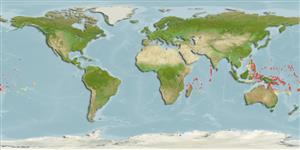Classification / Names
Common names from other countries
Main reference
Size / Weight / Age
Max length : 2.3 cm TL male/unsexed; (Ref. 2334)
Environment
Marine; reef-associated; depth range 1 - 10 m (Ref. 1602)
Climate / Range
Tropical, preferred ?; 19°N - 24°S
Distribution
Indo-Pacific: Chagos Islands, Philippines, Great Barrier Reef, Fiji, and Samoa; Mariana, eastern Caroline and Marshall Islands in Micronesia.
Countries | FAO areas | Ecosystems | Occurrences | Introductions
Short description
Dorsal
spines
(total): 7;
Dorsal
soft rays
(total): 7-9;
Anal
spines: 1;
Anal
soft rays: 7 - 9. Characterized by semi-transparent head and body with white internal pigment over brain; upper surface of vertebral column white internal white stripe; ventral half of body with six faint reddish internal bars; lower half of body obscured by reddish brown to violet brown or purple streak and ending at caudal fin base; presence of brown saddles along back; all pectoral rays usually unbranched; longitudinal scale series 34-49; broad and disc-like pelvic fins, reaching to anus or beyond; opening of gill usually reaching to below rear edge of eye (Ref. 90102).
IUCN Red List Status (Ref. 115185)
Threat to humans
Harmless
Human uses
More information
Common namesSynonymsMetabolismPredatorsEcotoxicologyReproductionMaturitySpawningFecundityEggsEgg development
Age/SizeGrowthLength-weightLength-lengthLength-frequenciesMorphometricsMorphologyLarvaeLarval dynamicsRecruitmentAbundance
ReferencesAquacultureAquaculture profileStrainsGeneticsAllele frequenciesHeritabilityDiseasesProcessingMass conversion
Tools
Special reports
Download XML
Internet sources
Estimates of some properties based on models
Phylogenetic diversity index
PD50 = 0.5000 many relatives (e.g. carps) 0.5 - 2.0 few relatives (e.g. lungfishes)
Trophic Level
3.0 ±0.3 se; Based on size and trophs of closest relatives
Resilience
High, minimum population doubling time less than 15 months (Preliminary K or Fecundity.)
Vulnerability
Low vulnerability (10 of 100)
Price category
